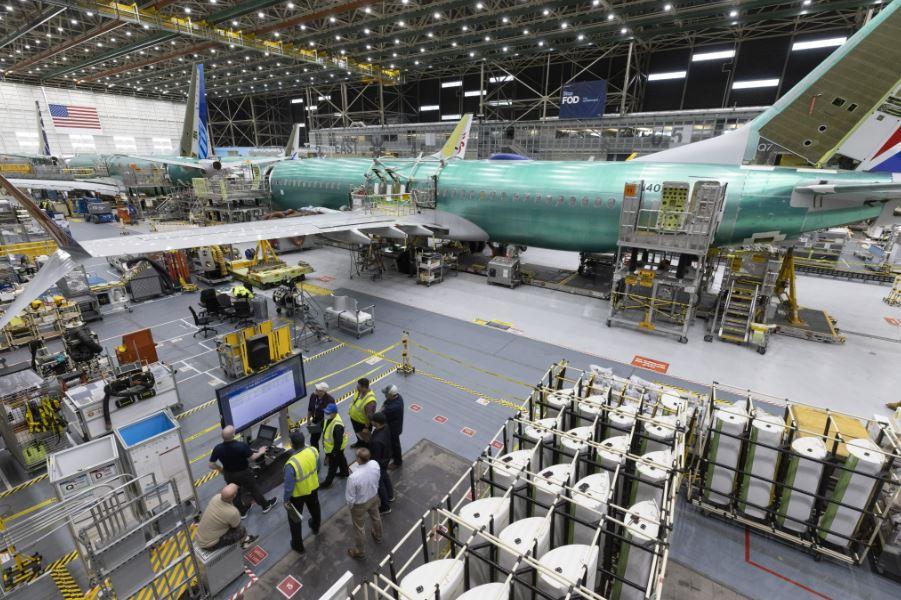
Boeing’s 2023 guidance assumes the 737 program could deliver as many as 450 aircraft, or 38 per month, but company executives caution that a rate increase needed to hit its top-end target cannot be counted on just yet.
“We have not snapped the line on the middle of next year” for a 737 rate increase, CFO Brian West cautioned during Boeing’s Nov. 2 investor event—its first since 2018. “We want to make sure we have the proof points in order for us to make that decision with enough lead time [for suppliers],” he added.
Boeing’s initial 2023 guidance includes a broad range of 400-450 737 deliveries. West characterized the 400 figure as a pessimistic bottom end of the range, “to give you a high confidence set of projections.” The company’s narrower target is 425-450, broken-down into monthly averages “in the low 30s” for the first half of the year, stepping up to the “low 40s” in the back half of the year.
“That will give us time to continue to stabilize the supply chain in the factory and even talk about getting ready for a rate ramp,” West said.
The company did not provide any insight on 2024. Further out, Boeing’s 2025-2026 guidance sees 737 production ramping up to an average of about 50 per month as part of a plan to deliver a total of about 800 commercial airplanes annually. The total includes producing about 14 widebodies per month—10 787s and four 777s. It also factors out China due to ongoing uncertainty around both orders and deliveries of aircraft to the country.
“We’ve de-risked China for the foreseeable future,” West said.
Boeing made it clear that while not set in stone, its preference is to be producing 38 737s per month—most of the 737 MAX variants for airlines with a few business jets and military aircraft mixed in—sometime in 2023, preferably around mid-year. Many suppliers are producing at or close to that rate already, and Boeing has hired the personnel required to do the work—a key sign of Boeing’s intentions.
“We typically like to bring our resources in about six months in advance” of a production-rate increase, said Boeing Commercial Airplanes unit President and CEO Stan Deal. That gives new hires time for training before being assigned to production lines, he said.
In this case, Boeing may stand up a third 737 production line to provide an incremental bump-up to 38 aircraft, Deal said.
“We will probably fire a third line early, just to give us some capability to get those Rate 38 people practice on a dedicated line,” he said. “It may run at a much different rate than the other two lines there.”
Boeing CEO Dave Calhoun emphasized that his company’s confidence in CFM International’s ability to deliver enough engines to support the rate bump is a key factor in determining when 737 production will increase.
“When we get to that moment, where that weekly rate hits the number we think is required to get our rate increase, we’ll announce it that day,” Calhoun said, adding that the GE Aerospace-Safran joint venture is confident it can deliver the engines Boeing needs, though no firm deal has been struck.
“There is what they say they can do, and there is what has been demonstrated,” Calhoun said. “Those lines have to meet, and I think they are determined to get those lines to meet. Every week that goes by where it looks like those are meeting, we will have more and more confidence to hit the rate break.”
Supplier consistency feeds into Boeing’ most important 737 production priority—stabilization. Boeing’s current notional 737 production rate is 31 per month. Analysts at Jefferies noted that the company is “loading” its 737 production lines at a 31 per month rate, but actual roll-outs have not kept pace, due to various issues.
MAX-family deliveries totaled 267 through September, or about 29 per month, including aircraft from stored inventory built up during the model’s 21-month global grounding and related delivery pause that ended in December 2020.
The company’s 2023 delivery projections suggest this will not change soon, meaning actual roll-outs will likely be somewhere in the mid-20s every month, with aircraft coming from storage pushing delivery hand-overs up into the 30s.
Jefferies analysts who toured Boeing’s 737 factory as part of the company’s investor day program concur. They see 737 MAX production averaging 23 units per month this quarter, 25 per month in the first half of 2023, and 31 per month in the second half of next year.
While engine supply has been cited for much of the 737 production-rate drag, Boeing acknowledges that internal issues continue to play a role.
Two fuselage defects flagged by the company’s now-routine and more comprehensive quality-assurance reviews held 737 deliveries down to just 23 in October, well below the year-to-date average of 29. “It delayed deliveries, but we will recover on that quickly,” Deal said.
Calhoun suggested such snags are a positive sign of how Boeing has changed in the wake of the 737 MAX crisis and 787 production-quality struggles.
“Strict compliance is every airplane that leaves your tarmac and gets delivered to a customer will be 100% conforming to the engineering specs that [Boeing] delivered in certification, and I mean precisely,” he said. “In the old days, there was a very inefficient process ... where we worked through those things, determined there was no safety [risk] involved, and we’d be able to move these things through the system,” he continued.
Now?
“No more,” Calhoun said. “Zero.”
That goes for production-line flow as well, even if it means voluntarily sacrificing higher monthly totals.
“We are going to have month-to-month instability based on a quality issue here or there or no-delivery out of our supply chain,” Calhoun said. “If it’s because we paused a line and didn’t travel something [incomplete] to the next [place on the line], I view that as a badge of courage and actually reward people for that.”




